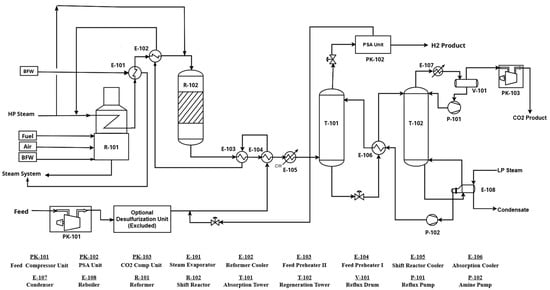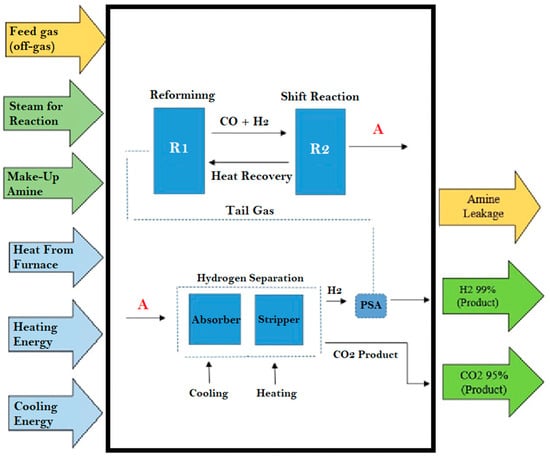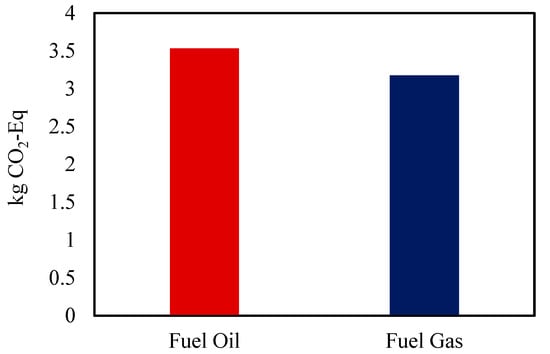Abstract
Global warming is partly attributed to the off-gas from petrochemical plants. This can be utilized as a feed to produce hydrogen (H2) as a promising measure for battling climate change. In this study, we evaluated the potential for converting waste off-gas to H2 via steam-reforming technology accompanied by a carbon capture unit, through hybrid absorption/adsorption processes, to achieve a 99.99% hydrogen product. Also, the ReCiPe methodology was used for environmental analysis. The results showed that the equivalent greenhouse emissions when producing of 1 kg of H2 were 3.53 kg CO2-Eq, which were almost 2.5 times lower than those for H2 production without carbon capture, i.e., grey H2. Also, it was shown that using refinery gas as a reforming furnace fuel instead of conventional fuel oil led to about an 11% decrease in emissions.
1. Introduction
The waste gases that are emitted during industrial operations are referred to as “off-gas”, which is known as one of the main causes of global warming and environmental issues []. Off-gas can be turned into a useful tool for battling climate change when it is consumed as a feedstock for the production of hydrogen. It is said that H2 has emerged as a promising solution due to its versatile applications and its potential to decarbonize various sectors of the economy []. Depending on the production routes, it has a comparatively high power density and minimal carbon emissions when used across its life cycle []. This transformation can be made possible through a variety of processes, including steam reforming, auto-thermal reforming, and partial oxidation []. Today, hydrogen is mainly produced by steam-methane-reforming technology, a mature production process in which high-temperature steam (700–1000 °C) is utilized to generate H2 from a methane (CH4) source, such as natural gas, LPG, refinery off-gases, etc. []. In steam-methane reforming (SMR), methane reacts with steam under 3–25-bar pressure to produce hydrogen, carbon monoxide, and a relatively small amount of carbon dioxide. Steam reforming is endothermic and, accordingly, heat must be supplied to the process for the reaction to proceed. Afterward, in a complementary reaction called the “water–gas shift reaction,” the carbon monoxide and steam are reacted using a catalyst to produce CO2 and more hydrogen []. In this study, we analyzed hydrogen production from cracking unit waste gas via steam-reforming technology accompanied by a carbon capturing unit, through hybrid absorption/adsorption processes, utilizing MEA amine absorption and a zeolite adsorbent as the commercial separation substance [,]. Also, for life cycle assessment of H2 production, the ReCiPe methodology was used. We sought to compare the effects of carbon capture in hydrogen production as a functional unit, and the effect of using refinery gas as reforming furnace fuel instead of conventional fuel oil was determined.
2. Material and Methods
2.1. Feed Condition and Design Assumptions
It was assumed that the feedstock for this production plant was delivered at a moderate pressure and temperature from the existing refinery and petrochemical complex in Terneuzen, Netherlands, such as its cracking units, which include light hydrocarbons, mainly methane and ethane, without a sulfur content. The plant’s capacity was regarded as 280 kilotons per year, and the utilities were considered at the plant battery limit based on process requirements. These assumptions are summarized in Table 1.

Table 1.
Summary of feed conditions.
2.2. Process Description
Based on the initial assumptions and selected technologies, including steam reforming, amine absorption, a pressure swing adsorption (PSA) unit, and CO2 compression and dehydration, a process flow diagram of the intended system is shown in Figure 1. Since feedstock must be received at a moderate pressure to achieve the intended pressurized conditions, a 4-stage compressor package was required. The feed was warmed by a pre-heating section, including exchangers that used existing heat from downstream. The feed was then mixed with steam as the main reactant in this system and again heated by the reformer’s furnace to achieve the reaction’s preferred temperature condition, which was 871 °C. The products, including CO and H2, were cooled and then entered the shift reaction section, which generated the final products (H2 and CO2) at 371 °C. This stream was passed through the integrated exchangers to give its heat to the feed stream, but cooling energy was still required to achieve the intended temperature condition in the absorption column. In the absorption column, CO2 was absorbed by lean amine and the separated H2, and any other non-separated or reacted gas was sent to the pressure swing adsorption (PSA) unit for purification, which can provide 99.99% H2, while the tail gas was resent to the inlet section of the plant. At the same time, CO2 was separated in the stripper column, with almost a 95% molar content, and was entered into a compression stage for storage and transportation. It is worth mentioning that in the stripper column, there were demands for cooling energy for the condenser and heating energy for the reboiler.

Figure 1.
Process flow diagram of hydrogen production accompanied with carbon capture.
2.3. Process Simulation and Calculation
In this study, Aspen Plus version 12.1 was utilized for simulation, which offered the possibility of gaining a better understanding of the scales and conditions of each piece of equipment. In this regard, the feed was defined as 90% methane and 10% ethane in the component list, and NRTL was selected as the thermodynamic equation of state for solving the equations.
2.4. Life Cycle Assessment
Life cycle assessment (LCA) is a systematic approach used to evaluate the environmental impacts associated with a product, process, or service throughout its entire life cycle []. The LCA’s goal in this study was to assess the environmental impact of hydrogen gas production from cracking off-gas with CO2 capture.
The boundary on the intended system for the current life cycle assessment is indicated in Figure 2. The functional unit was the production of 1 kg of hydrogen gas, and it was assumed that the raw materials were not imported using transportation, but were delivered by pipeline. The energy and utility requirements of upstream plants and the storage of products were considered outside of the scope of this work. Furthermore, 2% of the amine flow was assumed to be a direct loss based on previous research []. The inventory data for impact assessment were determined based on the above assumptions and simulation results for the energy and material balance. With CO2 as a captured product, the subtraction method was used for estimating the environmental effects of the production of 1 kg of hydrogen from off-gas based on the ReCiPe methodology, including a varied number of characterization models to calculate different impact categories for the analysis.

Figure 2.
System boundary for LCA of hydrogen production.
3. Results and Discussion
Since the feed was delivered at a moderate pressure and temperature, the inlet compressors provided the required pressure for the system. The stream was heated and mixed by steam and after that additional heating by means of a furnace to reach the reforming reaction’s required temperature of 871 °C. Based on the intended calculated flowrates, the Aspen equilibrium reactor was selected, and based on the stoichiometric values and entered flows, the software calculated the output of the reformer reactor. It can be seen that a good amount of methane was converted to CO and H2. The simulation results for reaction section is shown in Table 2.

Table 2.
Simulation results for reaction section.
The outlet of the reformer was cooled to reach the required temperature of the shift reactor, which was 371 °C. Based on the calculated mass balance and stoichiometric values, the reaction in the shift reactor was defined, and the following Table 3 provides the results. It can be seen that a good amount of CO was converted to hydrogen. The resulting stream was cooled to about 50 °C.

Table 3.
Simulation results for absorber column (mol%).
As demonstrated in Table 3, it can be observed that the hydrogen content was improved to almost 90% in the gas outlet, which was directed toward the PSA unit, to obtain a 99.99% hydrogen purity. In the meanwhile, the rich amine, which included mainly impurities and water, was sent to the stripping column for regeneration of the amine and also provided the CO2 product as its gas outlet. When designing the stripper column, we sought to achieve nearly a 90% fraction of carbon dioxide in the outlet. In this regard, by means of a reflux ratio of 1.5, which is the optimum value for achieving the desired fraction, and adjusting the pressure, the intended separation was achieved with 20 theoretical stages. Based on the simulation, the condenser reduced the temperature of the gas from 120 °C to 76 °C and its reboiler worked at 148 °C. The following are the results of the stripper column. Table 4

Table 4.
Simulation results for stripper.
As mentioned in Table 4, it can be seen that almost all CO2 and other hydrocarbons are separated and the amine is regenerated to make it usable again in the absorber column. In the meanwhile, there is some water content in the gas stream, which required separation. During the compressor stages for CO2 pressurizing, separators should remove this water content. In addition, the amount of zeolite adsorbent for the PSA columns was calculated to be 102,570 kg based on Yavary et al.’s reported zeolite load capacity for separating the remained CO2 at a 17-bar operating pressure [].
Regarding the environmental analysis, Table 5 provides the relevant primary data transferred into a functional unit for 1 kg of H2 as the final product, which is associated with 5.46 kg of captured CO2 as a co-product. As it is also shown, multi-functionality is applicable in this system, and an environmental load distribution model was implemented in this study.

Table 5.
Primary data for functional unit.
Based on the ReCiPe methodology and its characterization models, three different mid-point impact categories were calculated for the analysis, as shown in Table 6.

Table 6.
Life cycle assessment result for environmental indicators for producing 1 kg of H2.
The LCA results proved that in the global warming category, the amount of equivalent greenhouse emissions for 1 kg of blue hydrogen production was 3.53 kg CO2-Eq, which was almost 2.5 times less than that for grey H2 production. Also, in the fossil fuel depletion category, the impact of blue hydrogen was 2.3 kg oil-Eq, while the production without carbon capture registered 4.14 kg oil-Eq in the same condition. Furthermore, the assigned water depletion impact when producing the intended amount of hydrogen was 0.02 m3.
As shown in Figure 3, the greenhouse equivalent emissions generated by the system in which fuel gas was used amounted to 3.17 kg CO2-Eq, while those for conventional fuel oil totaled 3.53 kg CO2-Eq. These results were achieved because of the inherently cleaner properties of gas as a lighter fuel compared to fuel oil, which consists of longer hydrocarbon chains.

Figure 3.
Effect of furnace fuel type on equivalent emissions for production of 1 kg of H2.
4. Conclusions
Off-gas is a significant cause of global warming and environmental issues. It can be repurposed to combat climate change by serving as a feedstock for hydrogen production. This study evaluated the conversion of off-gas to hydrogen using steam-reforming technology coupled with carbon capture through hybrid absorption/adsorption processes. The main limitation of this paper is the lack of access to the real feed composition. It was demonstrated that the greenhouse emissions when producing 1 kg of H2 amounted to 3.53 kg CO2-Eq, almost 2.5 times less than those for grey H2 production. Moreover, using refinery gas instead of conventional fuel oil in the reforming furnace could reduce emissions by about 11%. The water depletion impact when producing the intended amount of H2 was 0.02 m3. This study highlights the need for further research, including studies comparing the environmental and economic impacts of utilizing complete solid adsorption and solvent absorption in CO2 separation units. Additionally, studies considering the effects of utilities’ production at the same plant would enhance the research outcomes with more detailed and realistic data. Furthermore, providing comparative techno-economic studies for various design arrangements to achieve energy optimization and net-zero plants is a potential future research direction. Detailed and accurate economic analysis is also necessary to provide a clear outlook on hydrogen production from off-gas, such as from cracking units in refineries.
Author Contributions
Methodology, M.S., A.N. and H.I.; software, M.S. and A.A.; validation, M.S., M.V. and H.I.; formal analysis, M.S., A.S. and S.O.; data curation, M.S. and H.I.; writing—original draft preparation, A.S., S.O. and M.S.; writing—review and editing, H.I. and M.V.; visualization, M.S. and H.I.; supervision, M.V. All authors have read and agreed to the published version of manuscript.
Funding
This research received no external funding.
Institutional Review Board Statement
Not applicable.
Informed Consent Statement
Not applicable.
Data Availability Statement
Data are contained within the article.
Acknowledgments
The authors would like to acknowledge the University of Rovira i Virgili and DOW chemical company for their support of this project.
Conflicts of Interest
The authors declare no conflicts of interest.
References
- Chang, R.J. Crude Oil to Chemicals: Industry Development and Strategic Implications. Ind. Arene Chem. 2023, 1, 43–69. [Google Scholar] [CrossRef]
- Andriani, D.; Bicer, Y. A Review of Hydrogen Production from Onboard Ammonia Decomposition: Maritime Applications of Concentrated Solar Energy and Boil-Off Gas Recovery. Fuel 2023, 352, 128900. [Google Scholar] [CrossRef]
- Liu, N.; Wang, Y.; Bai, Q.; Liu, Y.; Wang, P.; Xue, S.; Yu, Q.; Li, Q. Road life-cycle carbon dioxide emissions and emission reduction technologies: A review. J. Traffic Transp. Eng. (Engl. Ed.) 2022, 9, 532–555. [Google Scholar] [CrossRef]
- Dermühl, S.; Riedel, U. A comparison of the most promising low-carbon hydrogen production technologies. Fuel 2023, 340, 127478. [Google Scholar] [CrossRef]
- Oni, A.O.; Anaya, K.; Giwa, T.; Di Lullo, G.; Kumar, A. Comparative assessment of blue hydrogen from steam methane reforming, autothermal reforming, and natural gas decomposition technologies for natural gas-producing regions. Energy Convers. Manag. 2022, 254, 115245. [Google Scholar] [CrossRef]
- Chen, W.-H.; Chen, C.-Y. Water gas shift reaction for hydrogen production and carbon dioxide capture: A review. Appl. Energy 2020, 258, 114078. [Google Scholar] [CrossRef]
- Hsu, C.S.; Robinson, P.R. Springer Handbook of Petroleum Technology; Springer: Berlin/Heidelberg, Germany, 2017. [Google Scholar]
- Kumar, S.; Srivastava, R.; Koh, J. Utilization of zeolites as CO2 capturing agents: Advances and future perspectives. J. CO2 Util. 2020, 41, 101251. [Google Scholar] [CrossRef]
- Sonnemann, G.; Tsang, M.; Schuhmacher, M. Integrated Life-Cycle and Risk Assessment for Industrial Processes and Products; CRC Press: Boca Raton, FL, USA, 2018. [Google Scholar]
- Karl, M.; Wright, R.F.; Berglen, T.F.; Denby, B. Worst case scenario study to assess the environmental impact of amine emissions from a CO2 capture plant. Int. J. Greenh. Gas Control. 2011, 5, 439–447. [Google Scholar] [CrossRef]
- Yavary, M.; Ale Ebrahim, H.; Falamaki, C. Competitive adsorption equilibrium isotherms of CO, CO2, CH4, and H2 on activated carbon and zeolite 5A for hydrogen purification. J. Chem. Eng. Data 2016, 61, 3420–3427. [Google Scholar] [CrossRef]
Disclaimer/Publisher’s Note: The statements, opinions and data contained in all publications are solely those of the individual author(s) and contributor(s) and not of MDPI and/or the editor(s). MDPI and/or the editor(s) disclaim responsibility for any injury to people or property resulting from any ideas, methods, instructions or products referred to in the content. |
© 2024 by the authors. Licensee MDPI, Basel, Switzerland. This article is an open access article distributed under the terms and conditions of the Creative Commons Attribution (CC BY) license (https://creativecommons.org/licenses/by/4.0/).